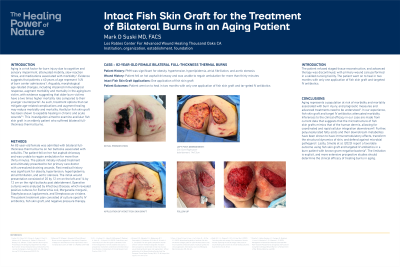Case Series/Study
(CS-157) Fish Skin Xenograft for the Treatment of Bilateral Buttock Burns in an Aged Patient

Aging is a risk factor for burn injury due to cognitive and sensory impairment, attenuated mobility, slow reaction times, and medications associated with morbidity1. Evidence suggests that patients ≥ 60 years of age represent 14% of burn center admissions1. Arguably, morphological age-related changes, including impaired immunological response, augment morbidity and mortality in the aging burn victim, with evidence suggesting that older burn victims have a two times higher mortality rate compared to their younger counterparts2. As such, treatment options that can mitigate age-related complications and augment healing may reduce morbidity and mortality. Acellular fish skin graft has been shown to expedite healing in chronic and acute wounds3,4. This investigation aimed to examine acellular fish skin graft in an elderly patient who suffered bilateral full-thickness thermal burns.
Methods:
An 82-year-old female was admitted with infected bilateral buttock full-thickness thermal burns. The patient fell on her hot driveway for more than thirty minutes. She initially refused treatment and ultimately presented one week later with draining wounds. Past medical history was significant for obesity, hypertension, hyperlipidemia, atrial fibrillation, and aortic stenosis.
The initial wound presentation consisted of 20 by 12 cm on the left and 14 by 12 cm on the right buttocks post debridement. Operative cultures revealed polymicrobial flora. The treatment plan consisted of culture specific IV antibiotics, fish skin xenograft, and negative pressure therapy
Results:
The patient refused staged reconstruction. Conservative wound care was performed in a skilled nursing facility. The patient went on to heal in two months with only one application of fish skin graft and targeted IV antibiotics.
Discussion:
Aging represents a population at risk of morbidity and mortality associated with burn injury, and prognostic measures and advanced treatments need to be understood1. In our experience, fish skin graft and target IV antibiotics attenuated morbidity.Inferences to the clinical efficacy in our case are made from current data that suggests that the microstructure of fish skin grafts mimics that of the human dermis, allowing for coordinated and rapid cellular integration downstream5. Further, polyunsaturated fatty acids and their downstream metabolites have been shown to have immunomodulatory effects, transform the structural dynamics of skin, and defend against microbial pathogens6. Lastly, Smolle et al. (2023) report a favorable outcome using fish skin graft and targeted IV antibiotics in a burn patient with known gram-negative bacteria7. Further extensive prospective studies should determine the clinical efficacy of treating burns in aging.

.jpg)